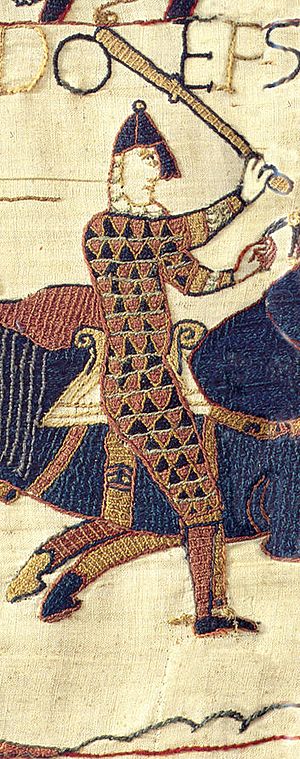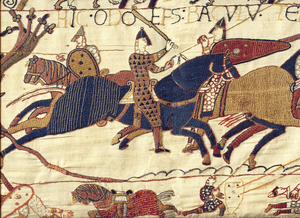Odo, Earl of Kent facts for kids

Odo, who lived from about 1030 to 1097, was the Bishop of Bayeux and the Earl of Kent. He was the half-brother of William the Conqueror, who became King of England. For a while, Odo was one of the most powerful people in England, second only to King William himself.
Contents
Odo's Life and Role
Early Years
Odo was born around the year 1030. His mother was Herleva, who was also the mother of William the Conqueror. Odo's father was Herluin de Conteville. Odo also had a younger brother named Robert, Count of Mortain.
Helping William Conquer England
Even though Odo was a Christian cleric (a church leader), he was also known as a brave warrior and a skilled nobleman. He played a big part in William the Conqueror's plan to invade England. Odo provided 100 ships for the Norman conquest of England in 1066.
Odo is one of the few people definitely known to have fought alongside William at the famous Battle of Hastings in 1066. Many historians believe he also helped create the famous Bayeux Tapestry, which tells the story of the Norman Conquest.
A Powerful Earl
In 1067, Odo was given the important title of Earl of Kent. For several years, King William trusted him greatly. When William had to go back to Normandy, Odo often acted as the de facto regent of England. This meant he was in charge of the country while the king was away. He even led royal armies to stop rebellions.
During this time, Odo gained a lot of estates and land all over England. He owned land in twenty-three different counties, especially in the southeast and in East Anglia.
Odo's Character and Actions
As the Earl of Kent, Odo became very well-known. He was seen as a very ambitious person. He was a good example of how the Normans took control of England after the conquest.
However, Odo was also a deeply religious man. He helped the church grow in England. One writer, Orderic Vitalis, who wrote about Odo much later, described him as a complex person. Orderic said that Odo had both good and bad qualities. He was very involved in worldly matters and was known for his ambition.
Odo's Downfall

In 1076, Odo faced a trial. He was accused of cheating the Crown (the king) and the Diocese of Canterbury (the church). After the trial, he had to give back many properties he had taken. Much of his wealth was taken away from him.
Then, in 1082, Odo was suddenly put in prison. This happened because he had planned a military expedition to Italy. He wanted to try and become the Pope. King William did not approve of this plan and stopped him.
Odo spent the next five years in prison in Rouen. The king took back his English lands and his title as Earl of Kent. However, Odo was allowed to remain the Bishop of Bayeux.
Odo was finally released from prison after King William died. In 1096, Odo joined the First Crusade with his nephew, Robert Curthose. He died in Palermo in early 1097 while staying there for the winter. He was buried in the Cathedral in Palermo.
Images for kids
-
Odo, club in hand, rallies Duke William's troops during the Battle of Hastings in 1066, as shown on the Bayeux Tapestry. Latin titulus above: HIC ODO EP[ISCOPU]S BACULU[M] TENENS CONFORTAT PUEROS ("Here Bishop Odo, holding a club, gives strength to the boys"). Duke William is also shown wielding a club during the battle in another scene
See also
 In Spanish: Odón de Bayeux para niños
In Spanish: Odón de Bayeux para niños


